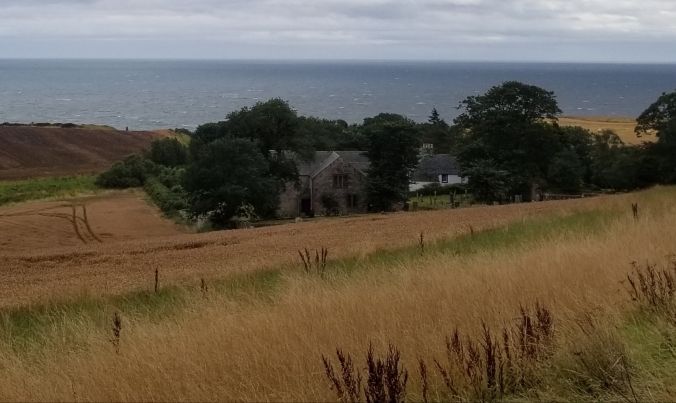William Ley married Margaret Watt in Fordoun, Scotland on April 29, 1698. William was from Aboyne in Aberdeenshire and Margaret was from Benholm, another village in Aberdeenshire. One of their children was Alexander, born in Fordoun on June 6, 1697, over 10 months before his parents’ marriage.
Alexander Ley lived in the Aberdeenshire village of Tipperty. On April 23, 1717 he married Christian Mowat in Fordoun. Although her name is shown as “Christian” on the marriage records, it may have been Christiane. She was from Fetteresso, a tiny hamlet at the edge of Stonehaven, in Kincardineshire. Their son William was born on June 19, 1718 in Tipperty.
On December 18, 1742 William Ley married Elizabeth Bruce in Fordoun. Elizabeth (christened on February 2, 1717) was the daughter of Alexander Bruce and Margaret Clark. Alexander Bruce was from the Mains of Fordoun, County Kincardine, Scotland. Kincardineshire lies to the immediate south of Aberdeenhshire on the northwest coast of Scotland and was historically known as “the Mearns.”
David Ley, son of William Ley and Elizabeth Bruce, was born on April 3, 1745 in Fordoun. A weaver, he married Isobel Burness on June 19, 1772 in Kincardine County. Isobel was the daughter of John Burness (of Fordoun) and Barbara Forbes (of Laurencekirk in Aberdeenshire). Barbara Forbes was the daughter of Alexander Forbes and Elizabeth Croll. David Ley and Isobel Burness had 11 children: Ann, William, John, David, Robert, George, Thomas, Elizabeth, Mary, Helen Athala, and Jean.
Helen Athala Ley, the tenth of the children, was born on June 15, 1796. She was christened in Auchenblae, a small village near Fordoun, probably at the parish church which was then known as the Fordoun parish church (and is possibly the Fordoun mentioned above). She married Thomas Henderson, a farmer, on July 20, 1817. They were married in the historic and picturesque Kinneff Kirk, in the seaside hamlet of Kinneff. The kirk is notable for being the place the Honours of Scotland were hidden after the were smuggled out of Dunnattor Castle while it was being besieged by Cromwell. I was privileged to be able to visit the church in September 2109.

Kinneff Kirk

A beautiful setting
Helen’s story is unusual, even by the standards of those times. In early 1820 she and her husband immigrated to the United States, along with their sons James Alexander (age 2) and Robert Hector (an infant), arriving in New York aboard the ship Euphrates. They traveled with a man named James Hector, whose relationship to them is unknown to me. After arriving in New York the Hendersons traveled to Washington County Virginia, where they lived with a wealthy man named Whitley Fullen. Washington County is not a typical destination for folks arriving in New York (by any means), leading me to believe that they must have traveled to the U.S. with the intent of going to live with Mr. Fullen, presumably at his invitation. According to family tradition (and, I’m told, confirmed by DNA), Helen’s last four children were fathered by Fullen. Their names were Malinda T. Henderson, Whitley Fullen Henderson, William Campbell Henderson and Hiram Fullen Henderson. Note that two of the boys were given “Fullen” as their middle name, which is what causes my suspicion about Robert Hector Henderson’s paternity. The story that has been passed down through the family for generations is that Thomas Henderson traded his wife Helen to Whitley Fullen for a horse, a saddle and a jug of whiskey.
The oldest child of Thomas Henderson and Helen Ley was James Alexander Henderson, born in Kincardine, Scotland on November 24, 1817, five months after his parents’ wedding. His story continues in the Henderson post.